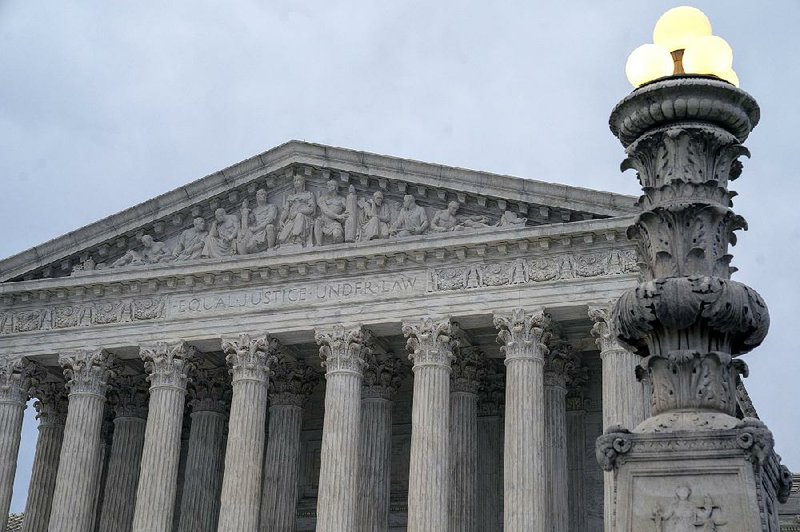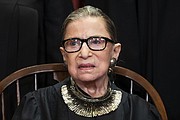WASHINGTON -- Justice Ruth Bader Ginsburg, who underwent cancer surgery last month, was missing from the bench Monday for the Supreme Court's first arguments since the court returned from its four-week holiday break.
Ginsburg has suffered a number of health setbacks over the years but has never before missed an argument in her 25 years on the court. It was not clear when she would return to the court, which will hear more cases today and Wednesday, and again next week.
Kathy Arberg, a court spokesman, said Ginsburg was working from home.
Chief Justice John Roberts announced his colleague's absence at the start of Monday's session, saying that "Justice Ginsburg is unable to be present today." He added that she would take part in the court's consideration of the day's two cases based on the briefs submitted by the parties and transcripts of the arguments.
Surgeons removed two nodules from Ginsburg's left lung Dec. 21. According to the justice's thoracic surgeon, Dr. Valerie Rusch, the nodules removed during surgery were found to be malignant, Arberg said at the time.
After the surgery, "there was no evidence of any remaining disease," Arberg said, adding: "Scans performed before surgery indicated no evidence of disease elsewhere in the body."
Ginsburg, 85, is the senior member of the court's four-member liberal wing.
Appointed by President Bill Clinton in 1993, Ginsburg rebuffed suggestions from some liberals that she should step down in the first two years of President Barack Obama's second term, when Democrats controlled the Senate and would have been likely to confirm her successor.
She already has hired clerks for the term that extends into 2020, indicating she has no plans to retire.
If she did step down, President Donald Trump would have another opportunity to move a conservative court even more to the right. On the day she had surgery, Trump tweeted his wishes for Ginsburg's "full and speedy recovery!"
Trump has appointed two new members to the Supreme Court, Justices Neil Gorsuch and Brett Kavanaugh. Should he name Ginsburg's replacement, Republican appointees would outnumber Democratic ones 6-3.
Ginsburg has been treated for cancer twice before, attributing her survival partly to the medical care she received at the National Institutes of Health.
"Ever since my colorectal cancer in 1999, I have been followed by the NIH," she said in the 2013 interview. "That was very lucky for me because they detected my pancreatic cancer at a very early stage" in 2009.
Doctors found the nodules removed last month during tests after a fall in November in which Ginsburg fractured her ribs. She had broken her ribs once before, in 2012. In 2014, she underwent a heart procedure.
She did not miss any arguments after the earlier procedures. She was also on the bench in 2010 on the day after the death of her husband, Martin Ginsburg.
Ginsburg has repeatedly vowed to stay on the court as long as her health holds and she stays mentally sharp. In 2013, she said she loved her work and intended to continue "as long as I can do the job full-steam, and that, at my age, is not predictable."
In 2004 and 2005, Chief Justice William Rehnquist missed many arguments during his treatment for thyroid cancer, though he continued to participate in the court's work. Rehnquist died in 2005.
Ginsburg is revered in liberal circles, with her many fans calling her Notorious R.B.G., a nod to the rapper Notorious B.I.G. The justice has embraced the connection. "We were both born and bred in Brooklyn, N.Y.," she likes to say.
She was born in 1933, graduated from Cornell in 1954 and began law school at Harvard. After moving to New York with her husband, she transferred to Columbia, where she earned her law degree.
She taught at Rutgers and Columbia and was a leading courtroom advocate of women's rights before joining the court. As director of the Women's Rights Project of the American Civil Liberties Union in the 1970s, she brought a series of cases before the court that helped establish constitutional protections against sex discrimination.
Her litigation strategy invited comparison to that of Justice Thurgood Marshall, who was the architect of the civil-rights movement's incremental legal attack on racial discrimination before he joined the court.
Information for this article was contributed by Adam Liptak of The New York Times, and by Mark Sherman of The Associated Press.
A Section on 01/08/2019

